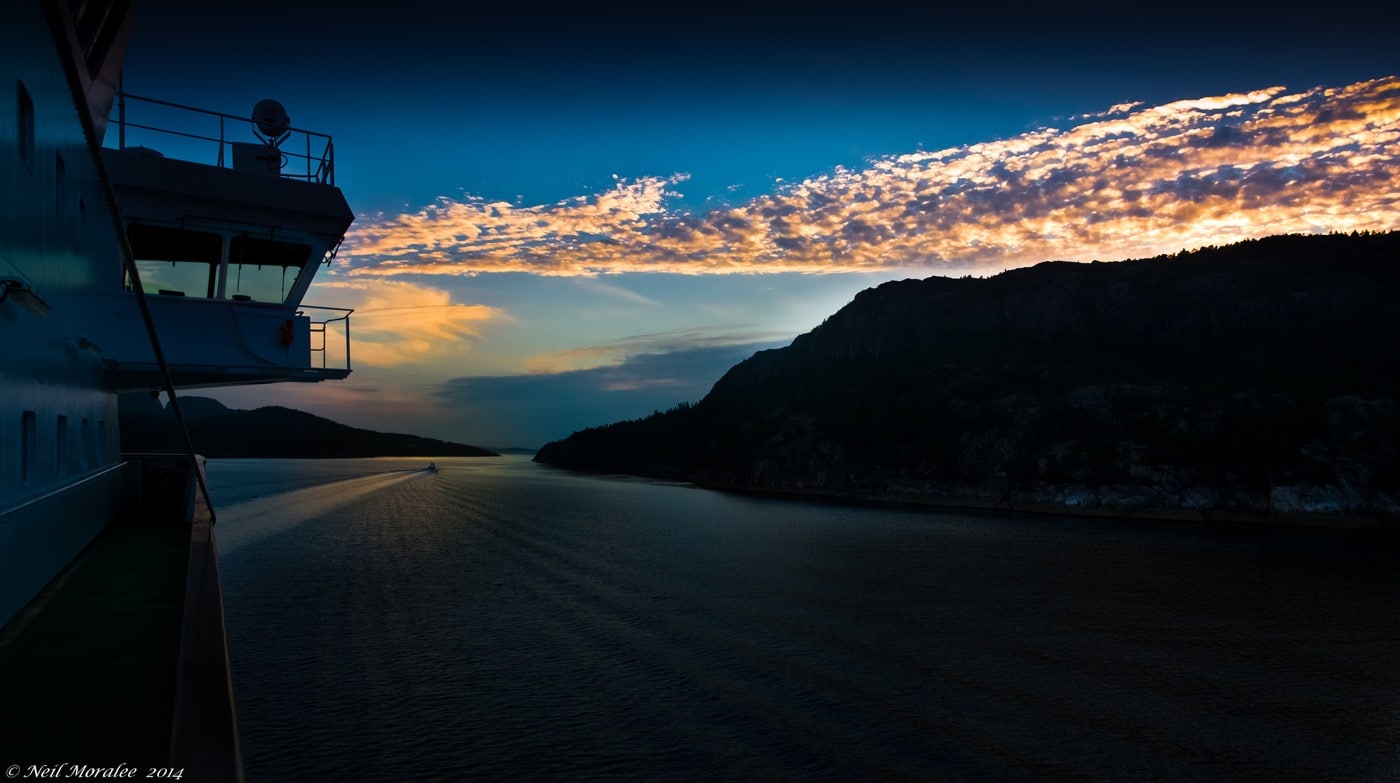It was like a magic carpet ride. Except that I was riding a rolling blue tapestry of three mighty waterways in Norway – the North Sea, the Norwegian Sea and the Barents Sea. Heading south along the coast from Kirkenes near the Russian border to the old Hanseatic city of Bergen, I’d cross the Arctic Circle and journey through more northerly climes than the boy with the lamp ever dreamt of. But my Norwegian coastal cruise offered the same thrill of discovery, the same exhilaration, the same sense of wonder. Every…single…day.
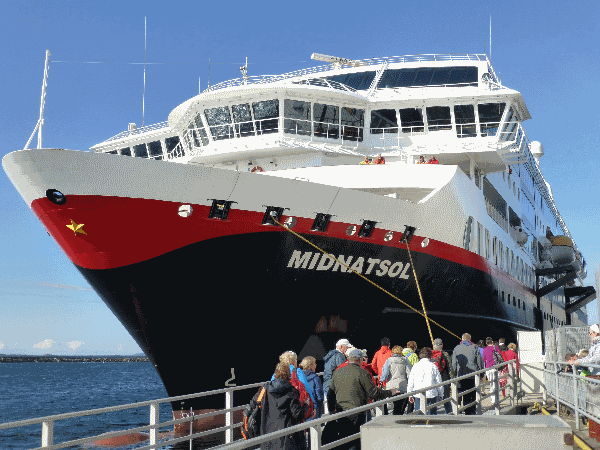
I was traveling aboard the M/S Midnatsol, one of a dozen ships of the legendary Hurtigruten line. Celebrating its 120th anniversary in 2013, Hurtigruten (meaning “fast route”) has ferried passengers, freight and mail between 34 ports since 1893. Today, Hurtigruten takes vacationers on 6, 7, 11 and 12 day coastal cruises, and further afield to Antarctica, Greenland, Iceland and Spitsbergen. Hurtigruten ships call at historic European cities and even make transatlantic crossings.
I took Hurtigruten’s six day Classic Coastal Cruise in summer. Though I’d heard of the thrills hunting winter’s Northern Lights, I wanted to travel in summer when the Midnight Sun illuminates the nighttime sky, when reindeer and other wildlife are most active, when sun-seeking Norwegians feel especially celebratory and when Hurtigruten’s shore excursions are most diverse.
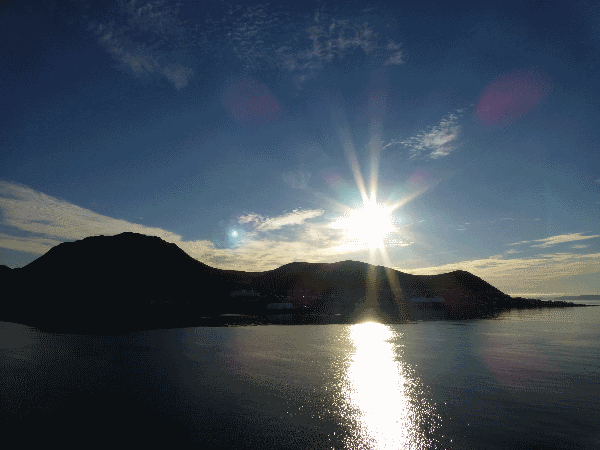
After a 7 ½-hour SAS flight from Newark to Oslo, I spent a couple days soaking up culture in the Norwegian capital, from Edvard Munch’s paintings at the National Gallery to contemporary art at the Astrup Fearnley Museum. I took in the Norwegian food scene, too, browsing through the fish, meat and gourmet food stalls at Oslo’s Mathallen, and sampling new Nordic cuisine at Ekebergrestauranten, perched high above the Oslofjord, and at D/S Louise, where brunost ice cream, made with caramelized Norwegian brown cheese, was a sweet surprise.
Then a two hour flight from Oslo took me to the far north to Kirkenes, a rugged border town 6 miles from Russia and 20 miles from Finland. From the small airport, filled with rod toting fly-fishermen bound for the region’s many salmon filled lakes, it was a quick ride to the Thon Hotel, overlooking the broad blue Bøkfjord, which flows into the 60 mile long Varangerfjord and on to the Barents Sea. I’d spend the night here with a group of colleagues from Baltimore, New York, D.C., Atlanta, San Francisco and Seattle.
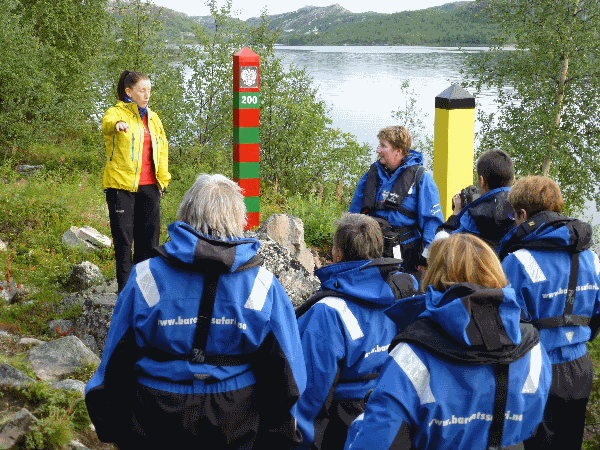
Though we weren’t sailing until the next afternoon, our Hurtigruten adventure was already underway here. All of us ready for a King Crab Safari, one of the line’s many shore excursions, we were soon on the Bøkfjord’s pebbled coast, pulling on black and neon yellow survival suits. Once we straddled saddle-like pommels in our sleek red and black RIB (or rigid hulled inflatable boat) Michael, our garrulous guide, rammed the accelerator, and we were off! From the fjord rose granite mountains, green islands and cabins painted barn red dotting the coast. We stopped to photograph a trio of reindeer high on a bluff. Then we were off again.
The big thrill came when Michael pulled up the traps filled with king crabs—giant red monsters with bodies as big as dinner plates and legs as long as a man’s arm. Ashore, Michael quickly dispatched a dozen crabs and steamed their three foot long legs. Inside his rustic fishing shack candlelight flickered on animal pelts and cod drying from the rafters. Sitting on crude benches covered with reindeer skins at a long wooden table, we cracked open crab legs with our bare hands and tore into the chunks of succulent white flesh. Giddy with pleasure, we swore we’d never tasted anything better.
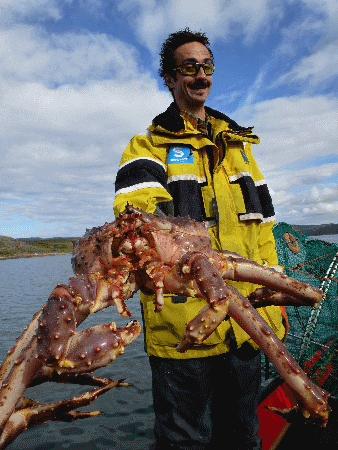
The next morning we explored the Andersgrotta cave where thousands of townspeople survived more than 300 Nazi bombings. Steps from the pretty Langfjord, a slender stretch of blue framed by birch trees, we toured the Borderland Museum tracing Norway’s relations with Russia and Finland. Then we hurried to port where our ship awaited, its black, white and red hull gleaming in the sunlight.
Though some had booked suites with outdoor decks or bay windows, I and many of the other 1,000 passengers checked into standard cabins. My cozy seagoing home featured royal blue wall to wall carpeting with a matching sofa, a burnished wood desk and closet, twin bed and a compact head with shower and large porthole. Unpacking quickly, I headed to the Restaurant Midnatsol for a buffet lunch of fresh shrimp, pickled herring, salads, cheeses and dessert, including that Norwegian favorite multekrem, golden cloudberries mixed with fresh whipped cream.
The ship had several comfortable lounges, including two sun-filled panoramic ones at the ship’s bow and two bars, one where a Norwegian pianist sang American pop standards from the ‘60s and ‘70s nightly in a charmingly incongruous accent. On the top deck, beyond the sauna and fitness area, I discovered my favorite spot – the wide, open air sundeck where you could bask in a deck chair, soak in a Jacuzzi or simply stand along the rails taking in the gorgeous scenery.
Crossing the Barents Sea we reached Vardø, our first port of call, in the late afternoon. Strolling past the 18th century fortress and the black and white steeple church sitting in a sea of pale purple wildflowers, I reached the Steilneset Memorial. Here two seaside buildings with a long black tunnel and a stark black cube housing only a flaming metal chair were harrowing tributes to scores of local women and men burned for witchcraft in the 17th century. The memorial, opened in 2011, was designed by artist Louise Bourgeois and architect Peter Zumthor and was Bourgeois’ last major work.
Over the next five days we cruised nearly 2,500 miles of sun dappled fjord and sea, passing hundreds of islands and scores of rocky skerries topped by miniature red and white lighthouses. We would see geological wonders like the 3,000 foot high Seven Sisters range and the Øksfjordjøkulen, one of Norway’s largest glaciers. At Torghatten Mountain, we gasped as the captain spun our ship around 360⁰ to glimpse the domed rock’s 525 foot long glacial hole, made (legend has it) when Hestemannen, the horse riding troll, shot an arrow chasing after the beautiful maiden Lekamøya.
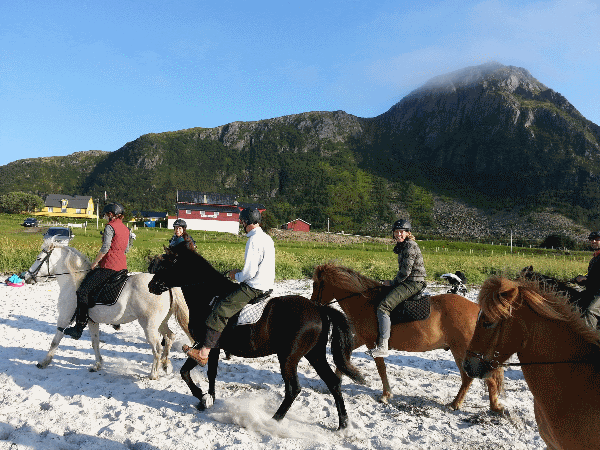
We would visit many of Norway’s most beautiful ports, from small fishing villages to larger ones known for commercial fishing. In Hammerfest, the world’s northernmost town, we were awed by the stained glass windows in Hammerfest Church. In Tromsø, Northern Norway’s largest city, a pianist, trumpeter and a baritone mesmerized us with a midnight concert of Edvard Grieg works. In Trondheim, Norway’s first capital, we toured medieval Nidaros Cathedral, a great European pilgrimage site. In Kristiansund we stood on the top deck delighted, as huge tankers crisscrossed the small harbor below like colorful red, yellow and green toy ships.
More than a chance to view a charmed coast, the Midnatsol was a launch pad to adventure. At 1 a.m. one morning under the glow of the Midnight Sun, we scoured hilly tundra on a reindeer spotting expedition. Driving slowly down the winding highway, Ruan, our guide, stopped whenever he spotted herds which included rare white reindeer and knobby-legged calves with stubby antlers. Having never seen reindeer grazing in the wild, each sighting was a thrill. Afterward, at a camp perched high above a fjord, we ate a breakfast of berry yogurt, fresh baked bread and reindeer meat roasted over an open fire. A few hours later we experienced another first standing high atop a bluff at the storied North Cape, the world’s northernmost point.
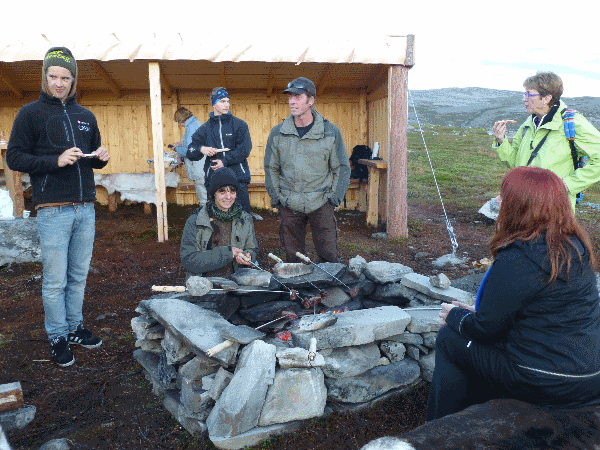
On a Sea Eagle Safari another day, we hopped a small boat and threaded our way through the high and narrow walls of the Trollfjord as majestic white tailed sea eagles, with eight-foot wing spans, wheeled overhead. At Hov Hestegård, a seaside horse farm in the Lofoten Islands, we saddled short, sturdy Icelandic horses and rode along a charmed landscape of white sand beaches shadowed by granite peaks.
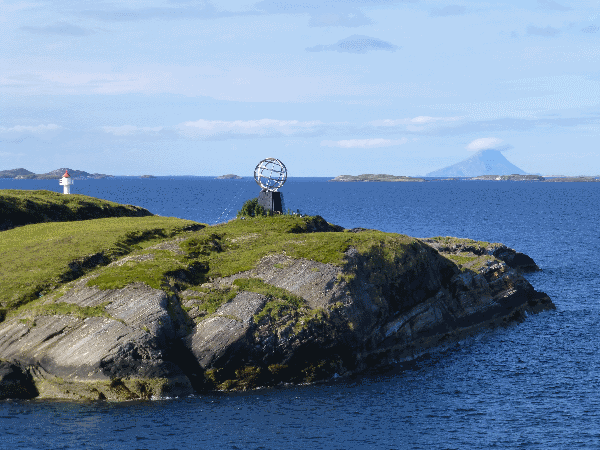
Halfway through our cruise we crossed the Arctic Circle, a milestone marked at sea by a steel globe atop a small island and aboard ship by a ceremony that included spoonfuls of castor oil and sips of sweet cloudberry wine. Exciting as it was, it was no match for our next excursion, a boat trip to the Vega Islands, a UNESCO World Heritage Site. Strolling among brightly colored cottages strewn like Monopoly pieces across a sun streaked harbor sheltering wooden fishing boats, we learned how the islanders for centuries had cared for eider ducks, who returned every year, leaving behind their precious down to be made into warm comforters.
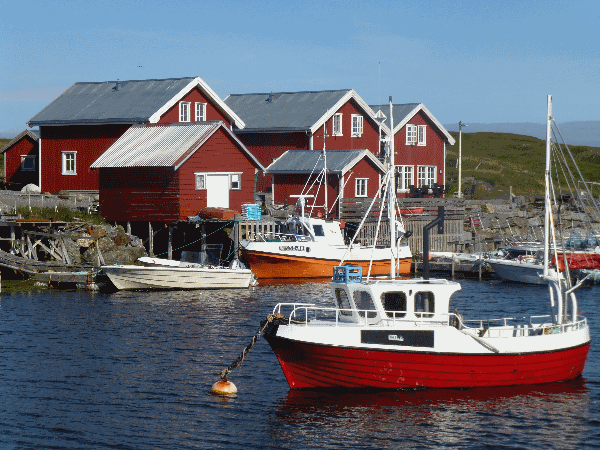
Two days later our ship pulled into Bergen, our final port of call. For a couple days, I’d explore historic Bryggen wharf and the bustling fish market. But I was already homesick. Not for my house across the Atlantic, but for my cozy cabin aboard the Midnatsol. I longed for fresh crab, salmon and cloudberries, for the cheerful company of seagoing Norwegians, for reindeer, white-tailed eagles and other exotic wildlife, and for the incomparable beauty of fjord and sky. Aboard Hurtigruten, I had experienced more than a coastal cruise. I’d ventured into the heart of Norwegian culture, and I was forever changed.
The Hurtigruten Experience – Famed for year-round Norwegian coastal cruises, starting at $1,362 per person, the line also journeys to Antarctica, Greenland, Iceland, Spitsbergen and other locales. P.O. Box 451209, Sunrise, FL 33345, 866-552-0371; www.hurtigruten.us
[alert type=white]
The area code for Norway is 47.
Where to Stay:
Thon Hotel Oslo Panorama – Steps from Oslo’s Opera House and harbor, enjoy contemporary rooms, many with kitchenettes, a bright white breakfast room and a small courtyard. Rådhusgaten 7B, N-0151 Oslo, 47 23-31-08-00; www.thonhotels.no/oslopanorama
Thon Hotel Kirkenes – Featuring spacious well-appointed rooms with stunning fjord views and a sumptuous breakfast buffet. Johan Knudtzens Gate 11, N-9900 Kirkenes, 47 78-97-10-50; www.thonhotels.no/kirkenes
Comfort Hotel Holberg – A short walk from the Fish Market, discover modern lodgings and a cozy breakfast space. Strandgaten 190, N-5004 Bergen, 47 55-30-42-00; www.nordicchoicehotels.no
Where to Eat and Drink:
Ekebergrestauranten – Superb Oslofjord views vie with excellent new Nordic cuisine at this gleaming white hilltop aerie. Kongveien 15, N-0193 Oslo, 47 23-24-23-00; www.ekebergrestauranten.com
D/S Louise – Offering innovative fish and game dishes in a nautically inspired harborfront setting. Stranden 3, Aker Brygge, N-0250 Oslo, 47 22-83-00-60; www.dslouise.no
Baklandet Skydsstation – Norwegian comfort food, from waffles to fish soup, are served in a cozy yellow house by warm hearted women in red and white polka-dot dresses. Øvre Bakklandet 33, N-7013 Trondheim, 47 73-92-10-44; www.skydsstation.no
Jacobs Bar & Kjøkken – Enjoy stylishly conceived organic meat and fish dishes in a hip, brick-walled setting. Kong Oscarsgate 44, N-5017 Bergen, 47 55-54-41-60; www.jacobsbergen.no
*For more information on Norway travel, there’s no better tool than a DK Eyewitness Travel Guide.
[/alert]

